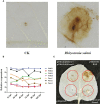Identification and characterization of pathogenicity-related genes of Rhizoctonia solani AG3 during tobacco infection
- PMID: 36733585
- PMCID: PMC9887180
- DOI: 10.3389/fpls.2022.1116506
Identification and characterization of pathogenicity-related genes of Rhizoctonia solani AG3 during tobacco infection
Abstract
Tobacco target spot disease is caused by a ubiquitous soil-borne phytopathogen Rhizoctonia solani; the pathogenic mechanisms underlying the effects of R. solani remain unclear. Deeper understanding of the functional responses to R. solani during host plant infection would help identify the molecular mechanisms essential for successful host invasion. In this study, we performed global transcriptional analysis of R. solani during various stages (12, 24, 48, 72, 96, and 120 h) of tobacco infection via an RNA sequencing method, while utilizing the pathosystem model R. solani AG3-tobacco (Nicotiana tabacum L.). After R. solani inoculation, the number of differentially expressed genes of R. solani differed at the various time points. Moreover, several gene ontology and Kyoto encyclopedia of genes and genomes pathways were unique in different infection stages, especially with respect to the genes involved in plant cell wall degradation and catalysis of biotransformation reactions, such as the pectin metabolic process and pectin catabolic process. The overexpressing-PD8 N. benthamiana plants enhanced the susceptibility to R. solani. In addition, we found that large amounts of reactive oxygen species (ROS) were generated in tobacco after infected by R. solani. R. solani encoding FAD/NAD binding oxidoreductase and peroxidase gene family to eliminating ROS and counteract oxidative stress. Moreover, Perox3 was validated that can enhance the ability of scavenging ROS by co-injecting. Overall, our findings show that pectin-degrading enzymes and cytochrome P450 genes are critical for plant infection. These results provide comprehensive insights into R. solani AG3 transcriptome responses during tobacco invasion.
Keywords: P450 genes; pectin; rhizoctonia solani; target spot disease; tobacco.
Copyright © 2023 Tang, Ma, Xiao, Xiao, Wang, Liu, Peng, Wang, Liu and Song.
Conflict of interest statement
The authors declare that the research was conducted in the absence of any commercial or financial relationships that could be construed as a potential conflict of interest.
Figures








References
-
- Ahsan T., Chen J., Zhao X., Irfan M., Wu Y. (2017). Extraction and identification of bioactive compounds (Eicosane and dibutyl phthalate) produced by streptomyces strain KX852460 for the biological control of rhizoctonia solani AG-3 strain KX852461 to control target spot disease in tobacco leaf. AMB Expr 7, 54. doi: 10.1186/s13568-017-0351-z - DOI - PMC - PubMed
LinkOut - more resources
Full Text Sources

